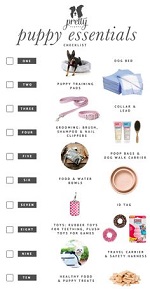
* Dog food: Choose a high-quality food that is appropriate for your new dogs age and size. Ask your veterinarian for recommendations.
* Food and water bowls: Food and water bowls should be heavy so that they cant be tipped or spilled easily. Stainless steel and ceramic bowls are best, although stainless steel bowls become hot when left in the sun. Plastic bowls can harbor bacteria. Raised bowls are ideal for larger and older dogs who have trouble stooping.
* Toys: Buy a selection of toys. High-quality rawhide and nylon bones provide dogs relief from teething. Plush toys and interactive toys like balls or Kings keep dogs busy.
* Grooming tools: A brush, flea comb, shampoo, and nail clippers are grooming regimen basics.
* Toothbrush and toothpaste: It is important to keep your do
gs teeth clean and healthy. Brushes and paste especially for dogs can be purchased at the pet supply store or from your veterinarian. * Crate: Chose a crate large enough so your dog can stand up and turn around in it comfortably but not so large that he can get away from any mess he makes. Some crates can be purchased with dividers that make the crate temporarily smaller, which may be a good choice for puppies. The crate will grow with them as they grow. A crate provides a comfortable spot in which to sleep and relax but is also an excellent tool for housetraining and keeping your dog safe when traveling. Cushion the floor with a blanket or fleece mat.
* Bed: If your dog isnt sleeping in a crate, hell need a comfortable dog bed.
* Collar and leash: Purchase an adjustable nylon or flat leather collar and check its fit often, especially if you are adopting a quick-growing puppy. You should be able to fit two fingers under the collar but it should be tight enough that it wont slip over you dogs ears. Use a 4 to 6 foot leash for walks.
* Identification tag: The ID tag should include your name, your dogs name, your address, and your phone number. If the tag allows for only two lines, they should be your dogs name and your phone number.
* First aid kit: A basic first aid kit helps you deal with minor emergencies.
* Baby gates: Use gates to block stairs or any area that is off limits to your dog.




